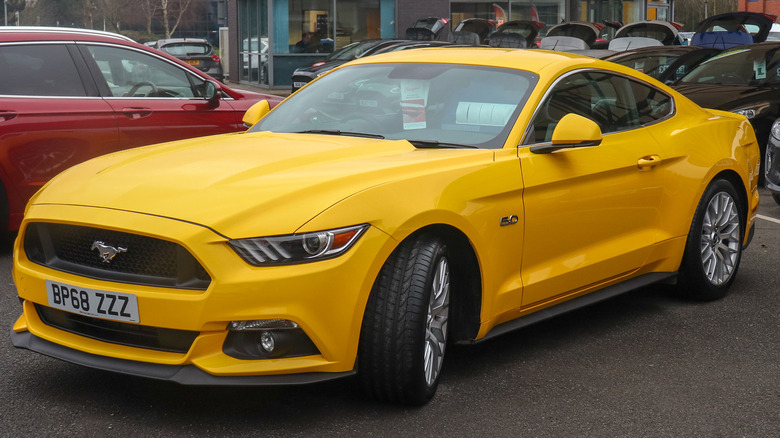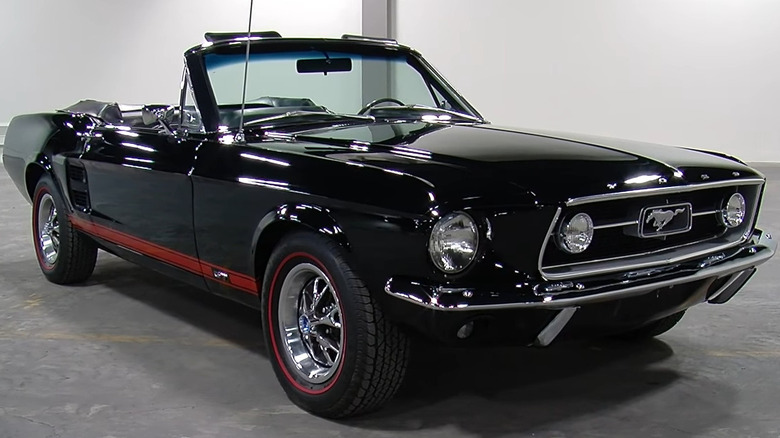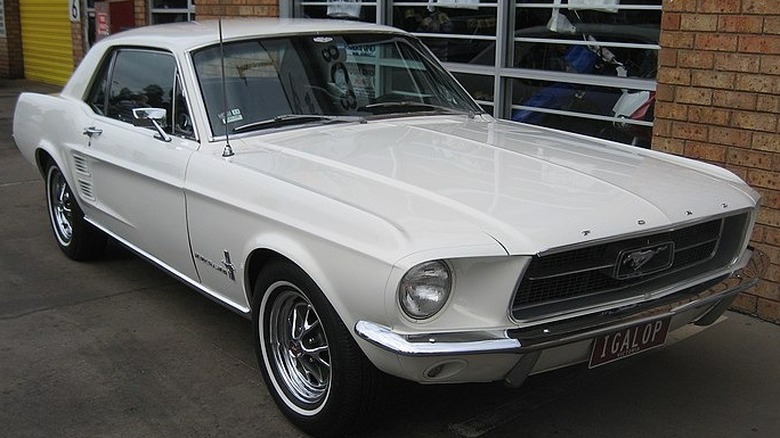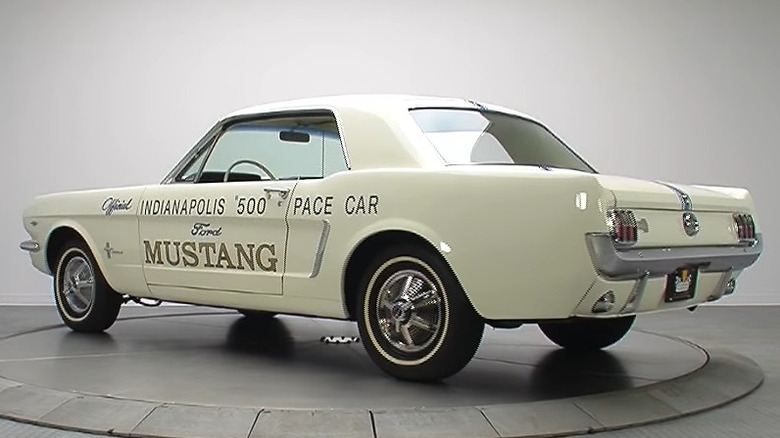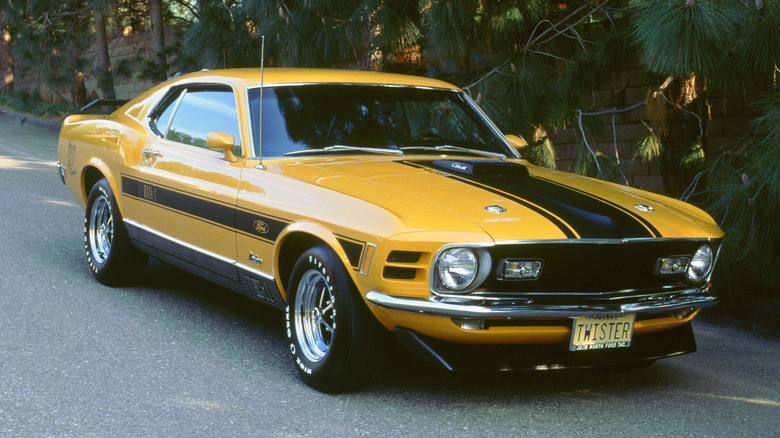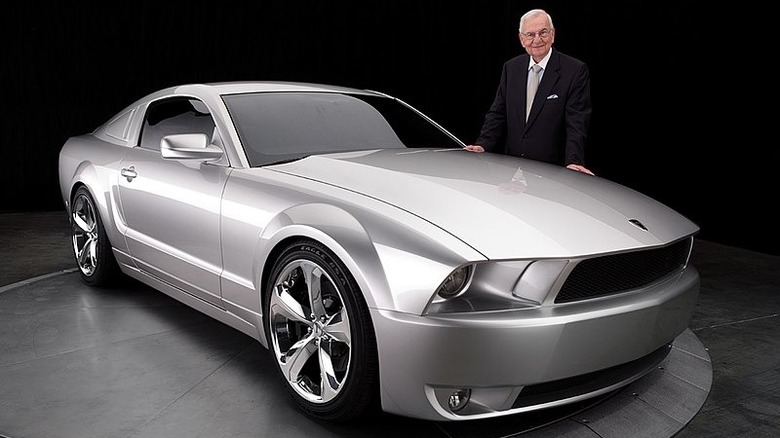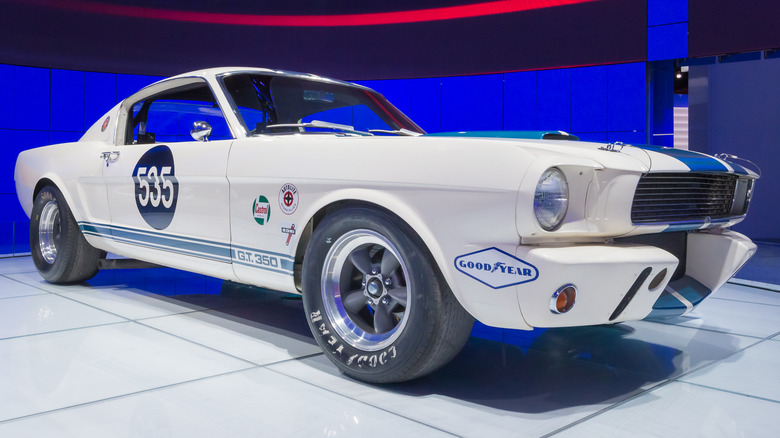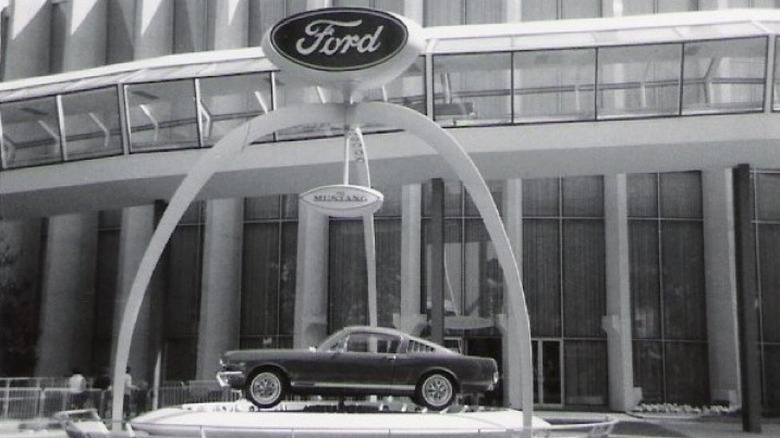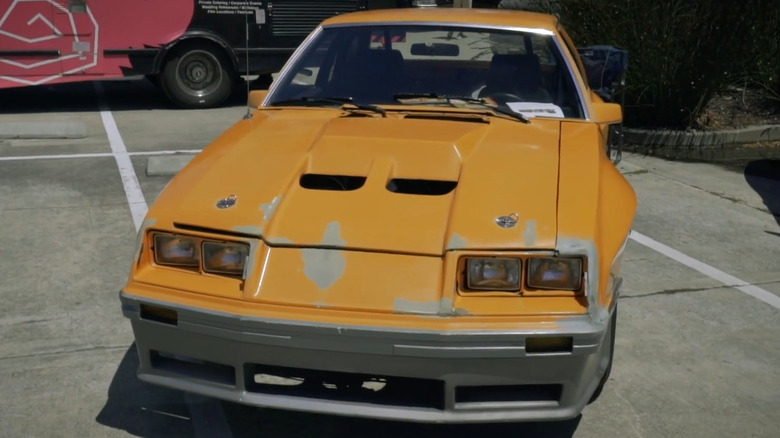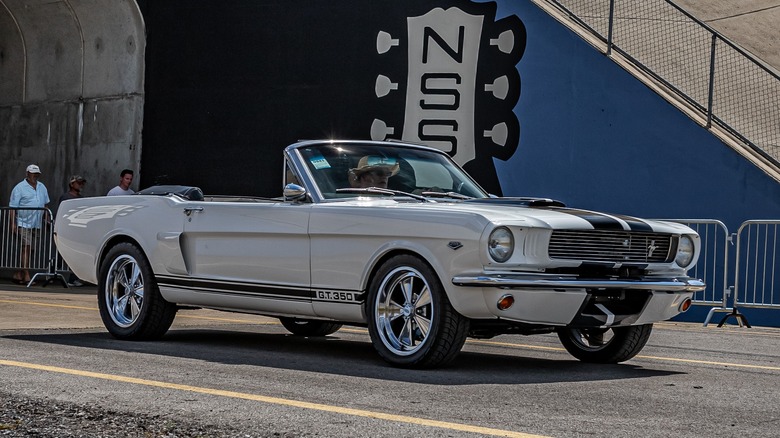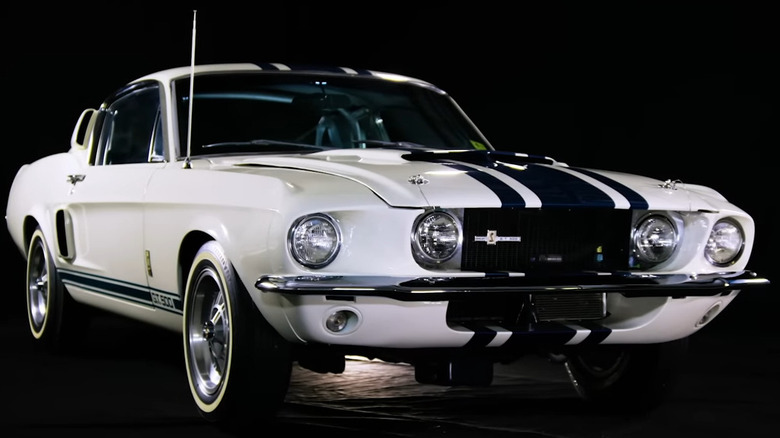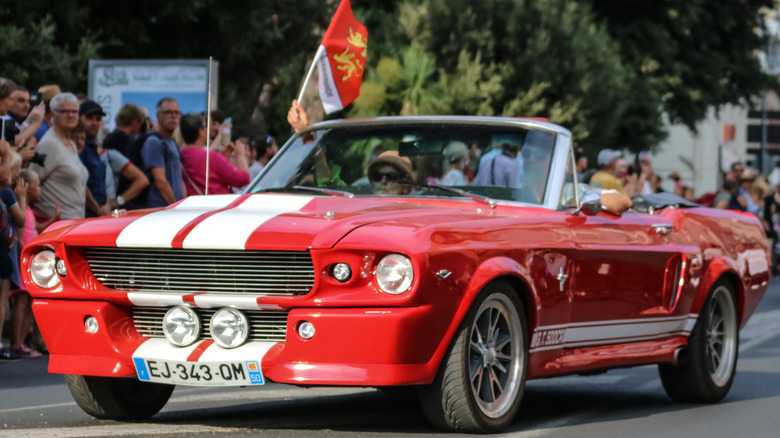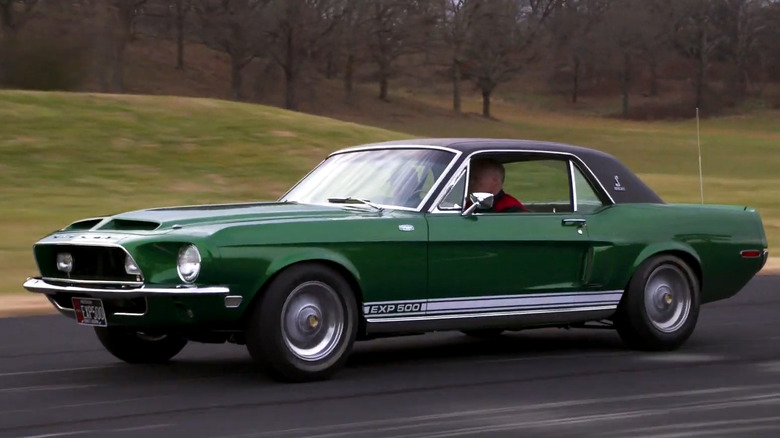12 Rarest Ford Mustang Models Ever Made
The Ford Motor Company has said that the Mustang was born from a desire to cater to a new market at the time: young, college-educated people, particularly women, looking for something stylish but not too costly. After extensive research, several designs, and an outpouring of love from the general public, the Mustang was officially launched on April 17, 1964, although there are stories of at least two that sold early. A pre-production model was accidentally sold to an airline pilot who would eventually trade it back to Ford for the millionth Mustang produced, and an Illinois teacher looking for her first car was offered a pre-release convertible on April 15. She still owns that Mustang to this day.
Overall, the Ford Mustang isn't that hard to find. Over 10 million have been produced, with the model never having missed a year since its 1964 inception. However, there are some specific Mustangs that are harder to find than others. Some were produced in limited quantities. Others are unique prototypes that somehow escaped the crusher. A few were one-offs made to serve a specific purpose. These 12 are the rarest of the rare, the Mustangs that double as unicorns in the minds of collectors around the world.
[Featured image by Vauxford via Wikimedia Commons | Cropped and scaled | CC BY-SA 4.0]
1967 Ford Mustang 289 HiPo (or K-Code)
1967 brought the first major redesign to the Mustang after its inception. It was a little longer, a little wider, and featured several interior differences and more available options than ever before. While over 472,000 Mustangs were produced by Ford for the '67 model year, the "HiPo" or "high power" branding is what sneaks this one onto our list. K-Code, or Hi-Po, refers to the engine offered in the Mustang — a 289 cubic inch, with 271 horsepower, but only 489 of the '67 model year Mustangs were equipped with this engine.
If one were to keep paring down options, even rarer versions of this car exist. Only 50 convertible K-Code Mustangs were produced in 1967, and of those, only 21 sported the "special competition suspension" option, according to Quality Classics. Only one went with a triple-black interior, exterior, top and deluxe interior — the one pictured above.
1967 Indy Pacesetter Mustang
Along with the redesigned Mustang, 1967 saw the introduction of the Chevy Camaro, offering Ford its first real competition in the "pony car" market they established three years prior. As part of its initial marketing blitz, Chevrolet got its Camaro the selection of pace car for that year's Indianapolis 500. In an effort to counter that advertising, Ford decided to make a special version of the Mustang for the central Indiana area.
According to Motor Trend, this Mustang was called the "Pacesetter" to emphasize that Ford continued to "set the pace" in pony car sales. And 324 of these clapbacks to Chevy were produced. They all featured Wimbledon White hardtops, blue interior, reflective blue side stripes and rear panel grille inserts. Most came equipped with a 289 cubic inch two-barrel V8. The rest had six-cylinders. Power steering was optional, and the Pacesetter came with either a three speed manual or automatic transmission.
While these aren't the rarest of vehicles, it is fun to think that a salty FoMoCo made 300-plus special Mustangs to drive and sell around Indianapolis for the express purpose of letting Chevy know that Ford wasn't backing down from a fight.
[Featured image by Sicnag via Wikimedia Commons | Cropped and scaled | CC BY 2.0]
1964 Indy Pace Car Replica
More the real thing than a "Pacesetter," Ford built three Mustang convertibles to pace the 1694 Indianapolis 500, while another 35 were assembled for a select few to drive during the surrounding festivities. Ford also produced around 180 replicas, hardtops that featured a special "Pace Car White" paint, white interior with blue appointments, and a 260 cubic inch two-barrel V-8 with a Cruise-O-Matic transmission.
Motor Trend says this replica series was created for Ford dealer sales contests. Dealers with the biggest sales increases would get free replica pace cars, with the only "catch" being that they had to go to Dearborn, Michigan, where Ford President Lee Iacocca would be waiting with a set of keys to their new Mustangs. Due to some inconsistencies in the various contests, Ford ended up producing 10 more of the pace car replicas, making for about 190 total. A small number to start, it's said that only nine of those cars still exist today.
1970 Ford Mustang Mach 1 Twister Special
As Mustang sales continued to flourish, Ford's Special Promotions Division began to offer regional specials for the model, according to Auto Evolution. With names like "High Country" and "Ski Country" for the Colorado market, "California Special" for the West Coast, and "Sidewinder" for Nebraska and Iowa, the division was clearly having a little fun with their new toy. The "Twister Special" was named for the tornadoes that occasionally touched down in the Kansas City, Missouri, area that requested a flashy, high performance supercar for a promotional event called "Total Performance Day," which was intended to be held on November 7, 1969.
American Raceways, International, or ARI, contacted Ford to request 1970 Mustangs to be used as pace cars and limited editions. At the time, ARI was the owner of racetracks in several American states. Ford agreed and designed special versions of the 1970 Mach 1 Mustang. Before the cars were shipped, however, ARI went into receivership and the Mach 1s were never delivered. Fortunately, Ford was able to repurpose those cars for the Kansas City promotion, providing 96 of them, all delivered in eye-catching Grabber Orange with black side stripes and a tornado decal on the rear quarter panel. Rare, sporty, and powerful, the Twister Special still can fetch a reasonable price, with one equipped with a 428 Super Cobra Jet engine selling just last year for $130,000.
2009 45th Anniversary Mustang Lee Iacocca Edition
This was a car designed to be rare from the start. It's named for the engineer-turned-marketing-executive, considered one of the fathers of the Mustang, Lee Iacocca, who went on to become President of Ford Motor Company. The innovative Pennsylvania native was a driving force behind many of Ford's best decisions in the 1950s and 60s. While he left the company in 1978, Iacocca was welcomed back in many marketing ventures afterward. That list included this unique opportunity to have his name forever emblazoned on a special edition of the car his name is forever synonymous with.
Mustang Fan Club describes the 45th Anniversary Mustang, released in 2009. Iacocca badging replaced the traditional Mustang badge throughout the vehicle. Handcrafted metalwork by the famed prototypers at the Gaffoglio Family Metalcrafters is featured as well. Modifications to the front end and interior leatherwork made the Iacocca Mustang even more unique and luxurious, and the fact that only 45 were produced made for instant collector status for this unique Mustang.
[Featured image by The World of the Ford Mustang via Wikimedia Commons | Cropped and scaled | CC-BY-SA-2.0]
1965 Shelby Mustang GT350R
Racecar designer and driver Carroll Shelby was pivotal in showing the world what a Mustang could become, even after he claimed the public perceived it as "a secretary's car," according to Mecum. Shelby was a legend in the racing world, and he was instrumental in Ford's racing division's resurgence as chronicled in the film "Ford vs. Ferrari." This was Shelby's first attempt to turn the gorgeous, popular, but slightly underpowered Mustang into something more, and he was wildly successful.
He and his team made a prototype GT350R, stripping the Mustang down to its most basic form and adding modifications to increase the 289 cubic inch V8's horsepower to over 350. It was put through the paces as both a test platform and a full-on race car. Several of the components tested on that prototype made it into the production version of the GT350R, although only 34 Rs were made, along with one more prototype. One of those two prototypes, nicknamed the "Flying Mustang," recently went for $3.85 million, making it the most expensive Mustang ever sold at auction. The first of five Shelby collaborations on this list, the GT350R is also one of the most iconic.
1964 World's Fair Skyway Mustang
The "Magic Skyway" Mustangs were 11 cars produced for a ride designed by Walt Disney himself for the New York World's Fair. Guests rode in convertible Fords, including the Mustangs, and traveled through time, checking out animatronic dinosaurs and other feats of engineering and technology. The fair was also where Ford introduced the Mustang to the world, making the Skyway Mustangs some of the first ever seen by the public. According to Ford, the product launch was "...one of the largest automobile and product launches in history."
Per Mecum, after the World's Fair closed in April of 1965, Ford transitioned these vehicles for use on the road and sold them in their "B" lot after adding some 1966 components like radios and hubcaps. While their engines weren't running during the ride, all of the Mustangs built for the Fair had 200 cubic inch inline 6-cylinder engine that packed 120 horsepower rather than the beefier V8 early Mustangs became known for. Of the 11 produced for the Magic Skyway ride, only three are verified to still exist. One that sold recently for $66,000 even retained the parts used to attach it to the Magic Skyway.
[Featured image by Doug Coldwell via Wikimedia Commons | Cropped and scaled | CC-BY-SA-3.0]
1980 Ford Mustang McLaren M81
The Mustang II was in an odd spot from its inception. Sandwiched in between the OG and Fox body ponies and based on the Pinto, the II was smaller, lighter, and basically worse version of a Mustang – but it provided fuel economy in a time when gas was at a premium due to OPEC embargoes. Still, when the economy rebounded, customers were ready to move on from the smaller, underpowered Mustang II.
Per The Drive, Ford partnered with racing shop McLaren to produce 10 M81s of an intended 249. "The engine and four-speed manual transmission were then blueprinted, disassembled, deburred, and rebuilt by hand by McLaren's engineering team in Livonia, Michigan," the publication notes.
They also modified the body and interior in a number of ways, large and small. Despite all that work, lagging sales and an extremely high cost of $25,000 led to only 10 being made. Seven were painted in a comedically appropriate color called "Bittersweet Orange." This rare Fox Body Mustang is still desired by collectors, although one with only 524 miles sold for $37,400 back in 2020, making this one of the more affordable Mustangs on this list.
1966 Shelby GT350 Convertible prototypes
Carroll Shelby was famously charming, and one of his many friendships led to the birth of a small rainbow of 1966 Shelby GT350 convertibles, per Street Muscle Magazine. Popular Kingston Trio musician Bob Shane struck up a bond with Shelby after purchasing a 1963 260 Cobra and a 1965 289 Cobra. Shane suggested to Shelby that if he ever made a GT350 convertible, he'd buy one in a heartbeat. Apparently that was enough to push Shelby to produce a few.
Shelby purchased four Mustang convertibles in April of 1966. He added the usual GT350 conversion parts, and painted each a different color: Sapphire Blue, Springtime Yellow, Ivy Green, and Candy Apple Red specifically for Shane. Unfortunately, the 1966 convertible was never widely produced, in part because Ford and Shelby had already moved on to the second-gen Mustang body style. In 2020, the Ivy Green car sold for a hefty $1.1 million.
1967 Ford Shelby Mustang GT500 Super Snake
According to Mecum, the Super Snake's inception was based on two factors. First, Goodyear asked Carroll Shelby to design something to test their new economy tires: the Thunderbolt line. After Shelby selected the GT500, he was approached by his sales manager to build a supercar for the test, and later add an additional 50 units. Alas, the prototype is the sole existing make of this vehicle, according to HotCars.
The Super Snake and the Thunderbolt tires performed admirably over a 500 mile test, one that was preceded by Shelby himself taking several of the assembled media for test laps in the modified Mustang. However, despite its impressive showing, a price tag that nearly doubled Shelby's GT500 proved too high for even the most discerning collectors. The one-of-a-kind supercar was sold to a pair of airline pilots and changed hands several times since. The Super Snake was sold at auction in 2019 for $2.2 million.
1967 Shelby GT500 Convertible
This one-of-a-kind Mustang has, arguably, one of the most fascinating histories of any car ever built. As recently as 2017, new information came to light that revealed its backstory as well as how it fit into the breakup of Ford Motor Company and Shelby American. Motor Trend has a lengthy article discussing the current owners and how their observations led to them digging up a ton of original documentation surrounding this convertible, the only one in existence.
When it was purchased in 1977, it was believed to be a 1968 Shelby GT Convertible, but the buyer noted several inconsistencies that led him to believe it might be a '67. Another owner was able to access Shelby American Auto Club archives, where they learned it was actually the only 1967 Shelby convertible ever made. Later research revealed that it was supposed to be part of a run labeled 1967 1/2 year of Shelby convertibles that ultimately didn't materialize, according to Motor Trend.
Part of the reason was rumored to be that the "buck," or pre-production model, that Ford provided Shelby was damaged, so Shelby's custom parts didn't fit the Mustangs acquired later. Because that put Shelby American behind on production, Ford took over and canceled the line, although that original convertible was produced at the San Jose plant's production line before heading to Shelby. It was later refitted with 1968 parts for photographs, sold, stolen, and eventually ended up in an Illinois car museum, where it was first displayed in 2004, according to Mecum.
1968 Ford Shelby EXP500 Green Hornet Prototype
A "double-prototype" turned collector icon, this 1968 Mustang was one of two pulled off Ford's Dearborn, Michigan, assembly line in late 1967, Motor Trend reported. Ford's engineers added Thunderbird tail lights and mounted fog lights on the grille as a test for its "California Special" or "GT/CS" series. After making the rounds at auto shows nationwide, Ford scrapped the alternate "GT/SC" project and sent one off to Shelby American for further modification.
Carroll Shelby and his chief engineer Fred Goodell painted the car a quirky emerald metallic green and dropped in "a 428-cubic-inch Cobra Jet engine; a C6 three-speed automatic transmission; an independent rear suspension; Conelec electronic fuel injection; and a wide assortment of body panel, lighting, and badging specific to the Shelby GT programs," according to Motor Trend.
The resulting masterpiece escaped the crusher – either because of Goodell or another important Ford alum at the time. It changed hands between Ford employees and a dealer in Michigan before being sold a number of times afterward. The car was later restored in the 1990s, although not to its original specs. It was restored in 2018, this time reverting back to mostly original parts and specs by the CEO of Barrett-Jackson, Craig Jackson, who has been in possession of the singular "Green Hornet" ever since.
